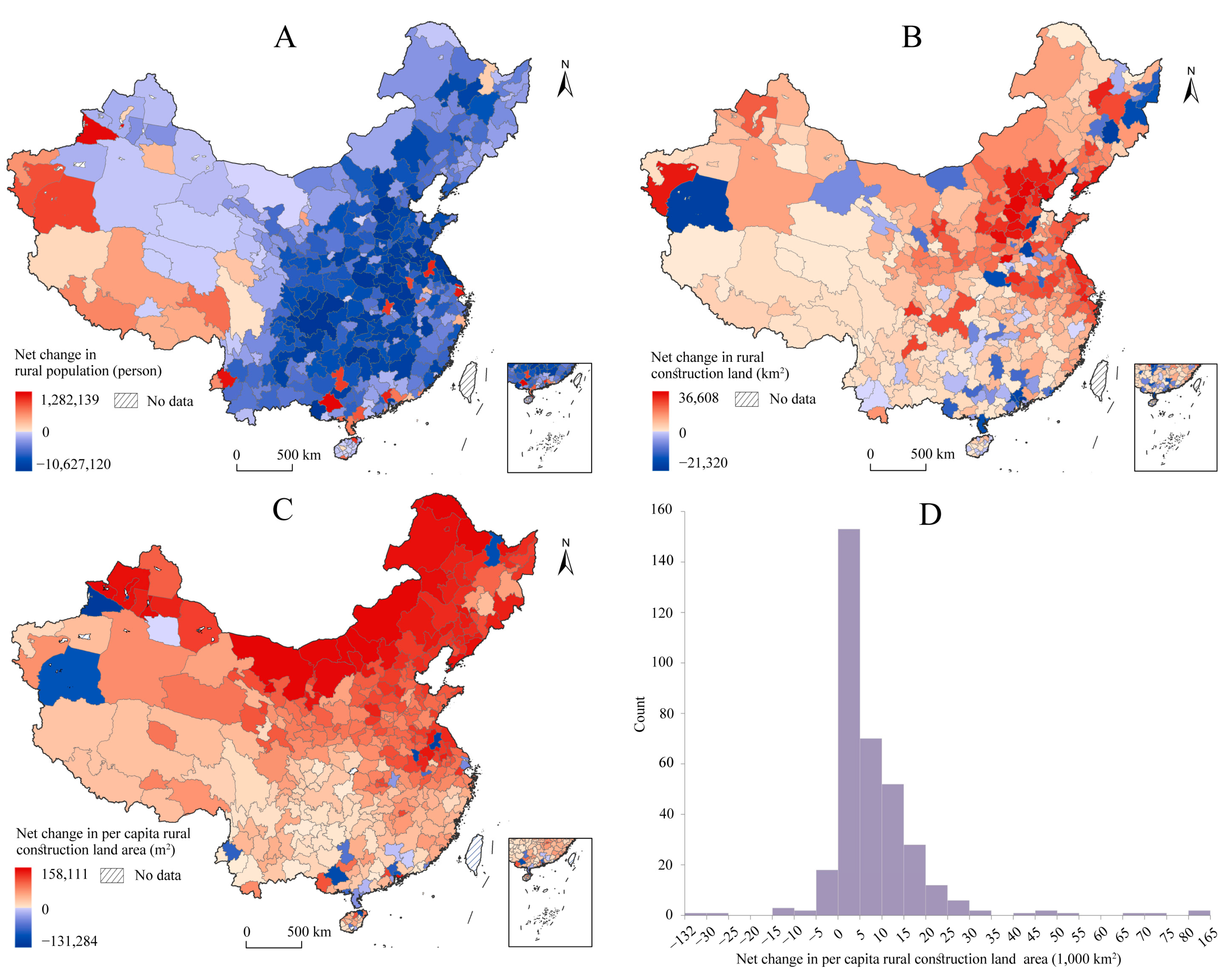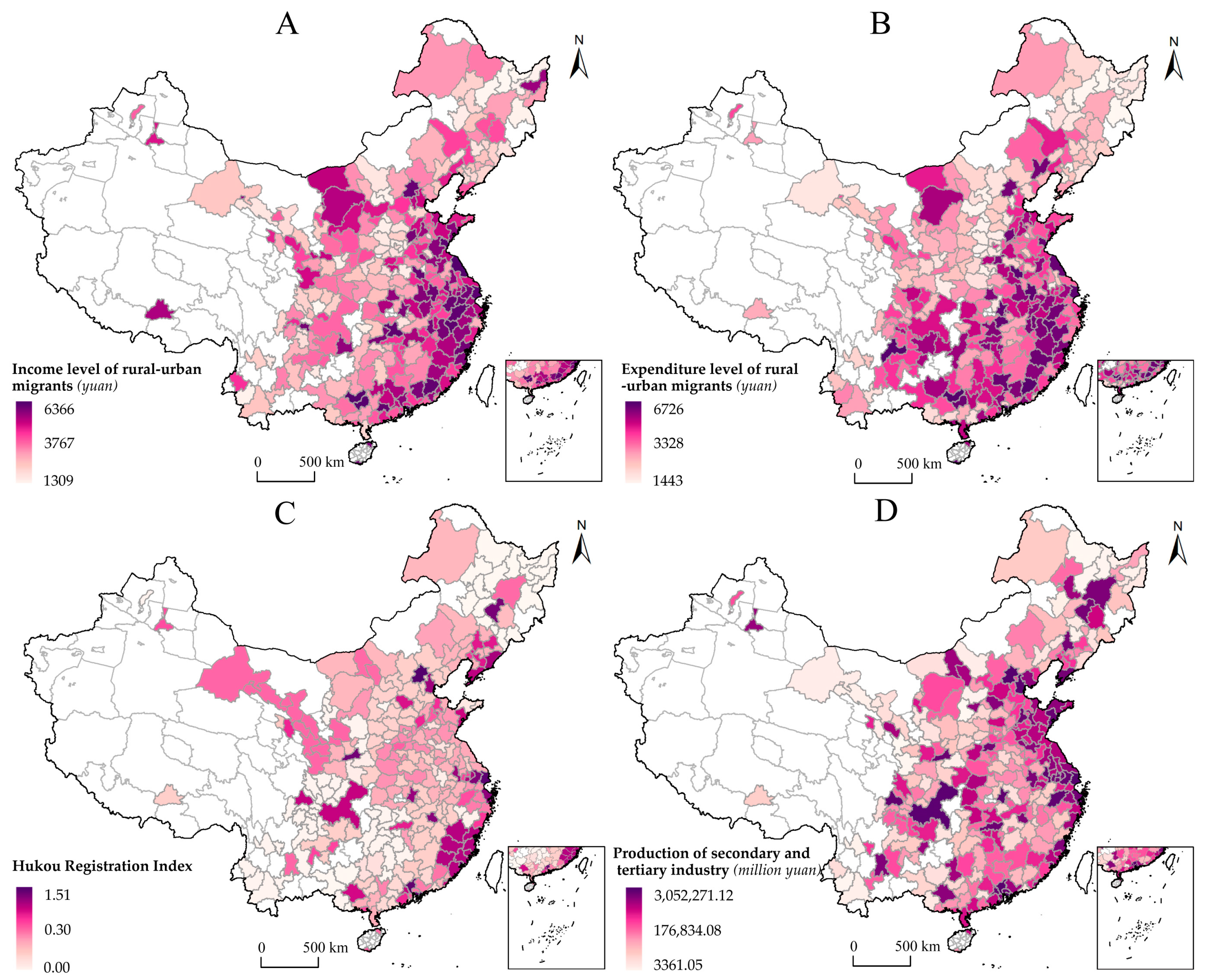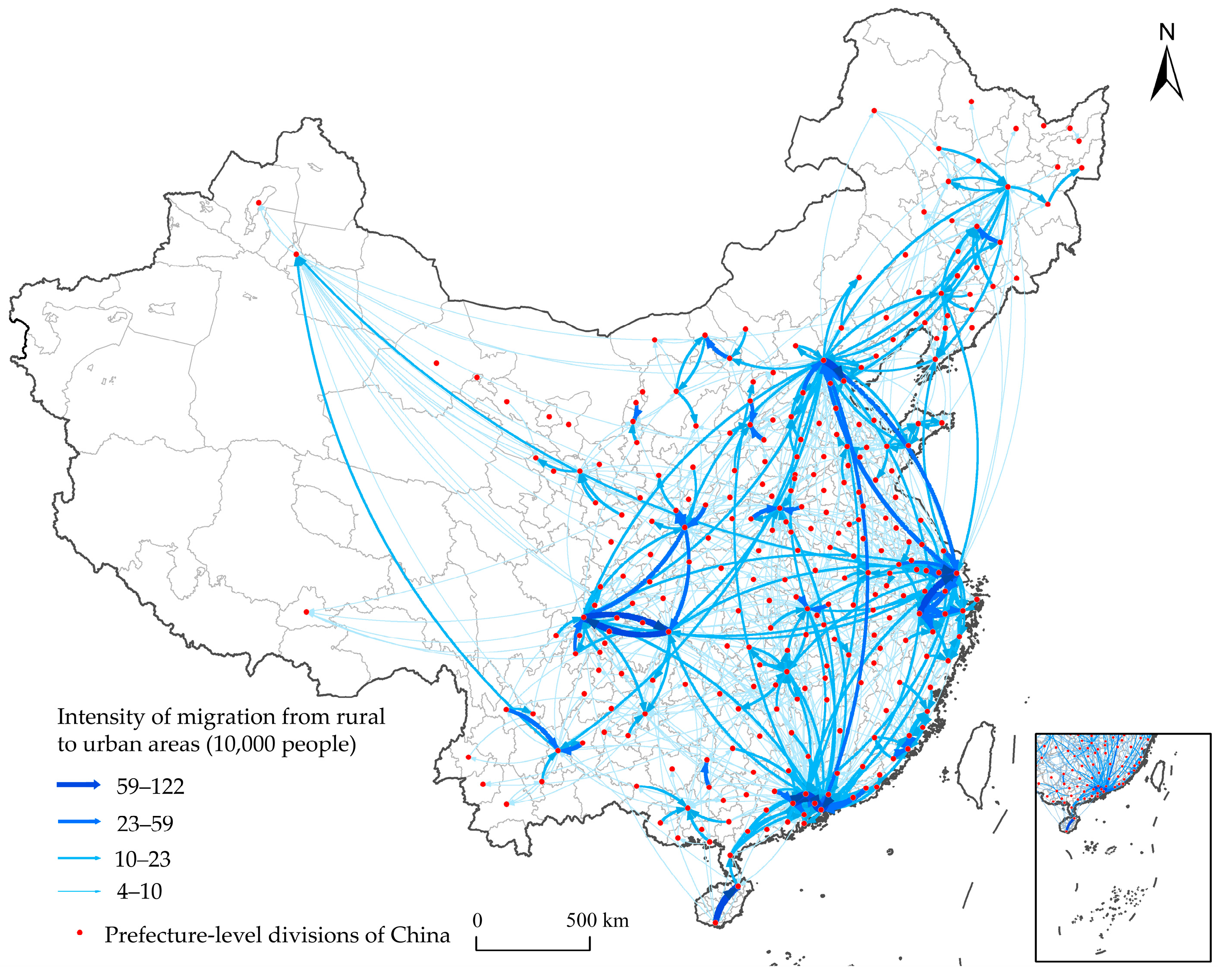How Semi-Urbanisation Drives Expansion of Rural Construction Land in China: A Rural-Urban Interaction Perspective
Abstract
1. Introduction
2. Materials and Methods
2.1. Theoretical Analysis and Hypotheses
2.2. Data and Variables
2.2.1. Data Sources
2.2.2. Variables Selection and Descriptive Statistics
2.3. Methodology
2.3.1. The Network/Spatial Lag of X (N/SLX) Model
2.3.2. Population Migration Network Matrix
3. Results
3.1. Regression Results from the N/SLX Model
3.2. Robustness Analysis
4. Discussion
4.1. Irrational Non-Localized Demand for Rural Construction Land
4.2. Policy Implications
4.3. Limitations
5. Conclusions
Author Contributions
Funding
Data Availability Statement
Acknowledgments
Conflicts of Interest
References
- Li, G.; Fang, C.; Qi, W. Different effects of human settlements changes on landscape fragmentation in China: Evidence from grid cell. Ecol. Indic. 2021, 129, 107927. [Google Scholar] [CrossRef]
- Zhou, Y.; Zhong, Z.; Cheng, G. Cultivated land loss and construction land expansion in China: Evidence from national land surveys in 1996, 2009 and 2019. Land Use Policy 2023, 125, 106496. [Google Scholar] [CrossRef]
- National Bureau of Statistics of China (NBSC). China Statistical Yearbook; China Statistics Press: Beijing, China, 2018.
- Xu, X.; Liu, J.; Zhang, S.; Li, R.; Yan, C.; Wu, S. China’s Multi-Period Land Use Land Cover Remote Sensing Monitoring Dataset (CNLUCC); Data Registration and Publishing System of the Resource and Environmental Science Data Center of the Chinese Academy of Sciences: Beijing, China, 2018. [Google Scholar]
- Li, Y.; Westlund, H.; Liu, Y. Why some rural areas decline while some others not: An overview of rural evolution in the world. J. Rural Stud. 2019, 68, 135–143. [Google Scholar] [CrossRef]
- Selod, H.; Shilpi, F. Rural-urban migration in developing countries: Lessons from the literature. Reg. Sci. Urban Econ. 2021, 91, 103713. [Google Scholar] [CrossRef]
- National Bureau of Statistics of China (NBSC). Main Data on the 5th National Population Census in China. Released on 28 March, Beijing. 2000. Available online: http://www.stats.gov.cn/sj/pcsj/rkpc/5rp/index1.htm (accessed on 23 October 2022).
- National Bureau of Statistics of China (NBSC). Main Data on the 7th National Population Census in China. Released on 11 May, Beijing. 2020. Available online: http://211.69.138.66/cache/7/03/www.stats.gov.cn (accessed on 23 October 2022).
- Johnson, K.M.; Lichter, D.T. Rural Depopulation: Growth and Decline Processes over the Past Century. Rural Sociol. 2019, 84, 3–27. [Google Scholar] [CrossRef]
- Simwanda, M.; Murayama, Y.; Ranagalage, M. Modeling the drivers of urban land use changes in Lusaka, Zambia using multi-criteria evaluation: An analytic network process approach. Land Use Policy 2020, 92, 104441. [Google Scholar] [CrossRef]
- Chen, Z.; Li, Y.; Liu, Y.; Liu, X. Does rural residential land expansion pattern lead to different impacts on eco-environment? A case study of loess hilly and gully region, China. Habitat Int. 2021, 117, 102436. [Google Scholar] [CrossRef]
- Liu, S.; Xiao, W.; Ye, Y.; He, T.; Luo, H. Rural residential land expansion and its impacts on cultivated land in China between 1990 and 2020. Land Use Policy 2023, 132, 106816. [Google Scholar] [CrossRef]
- Liyew, M.; Tsunekawa, A.; Haregeweyn, N. Land Use Policy Exploring land use/land cover changes, drivers and their implications in contrasting agro-ecological environments of Ethiopia. Land Use Policy 2019, 87, 104052. [Google Scholar] [CrossRef]
- Conrad, C.; Rudloff, M.; Abdullaev, I.; Thiel, M.; Löw, F.; Lamers, J.P.A. Measuring rural settlement expansion in Uzbekistan using remote sensing to support spatial planning. Appl. Geogr. 2015, 62, 29–43. [Google Scholar] [CrossRef]
- Long, H.; Heilig, G.K.; Li, X.; Zhang, M. Socio-economic development and land-use change: Analysis of rural housing land transition in the Transect of the Yangtse River, China. Land Use Policy 2007, 24, 141–153. [Google Scholar] [CrossRef]
- Randelli, F.; Martellozzo, F. Is rural tourism-induced built-up growth a threat for the sustainability of rural areas? The case study of Tuscany. Land Use Policy 2019, 86, 387–398. [Google Scholar] [CrossRef]
- Wang, Z.; Ou, L.; Chen, M. Evolution characteristics, drivers and trends of rural residential land in mountainous economic circle: A case study of Chengdu-Chongqing area, China. Ecol. Indic. 2023, 154, 110585. [Google Scholar] [CrossRef]
- Mann, S. Institutional causes of urban and rural sprawl in Switzerland. Land Use Policy 2009, 26, 919–924. [Google Scholar] [CrossRef]
- Yu, Z.; Wu, C.; Tan, Y.; Zhang, X. The dilemma of land expansion and governance in rural China: A comparative study based on three townships in Zhejiang Province. Land Use Policy 2018, 71, 602–611. [Google Scholar] [CrossRef]
- Adamiak, C. Cottage sprawl: Spatial development of second homes in Bory Tucholskie, Poland. Landsc. Urban Plan. 2016, 147, 96–106. [Google Scholar] [CrossRef]
- Ji, Z.; Xu, Y.; Sun, M.; Liu, C.; Lu, L.; Huang, A.; Duan, Y.; Liu, L. Spatiotemporal characteristics and dynamic mechanism of rural settlements based on typical transects: A case study of Zhangjiakou City, China. Habitat Int. 2022, 123, 102545. [Google Scholar] [CrossRef]
- Qu, Y.; Zhan, L.; Jiang, G.; Ma, W.; Dong, X. How to Address “Population Decline and Land Expansion (PDLE)” of rural residential areas in the process of Urbanisation: A comparative regional analysis of human-land interaction in Shandong Province. Habitat Int. 2021, 117, 102441. [Google Scholar] [CrossRef]
- Song, W.; Li, H. Spatial pattern evolution of rural settlements from 1961 to 2030 in Tongzhou District, China. Land Use Policy 2020, 99, 105044. [Google Scholar] [CrossRef]
- Ma, W.; Jiang, G.; Li, W.; Zhou, T. How do population decline, urban sprawl and industrial transformation impact land use change in rural residential areas? A comparative regional analysis at the peri-urban interface. J. Clean. Prod. 2018, 205, 76–85. [Google Scholar] [CrossRef]
- Liu, S.; Ma, L.; Yao, Y.; Cui, X. Man-land relationship based on the spatial coupling of population and residential land—A case study of Yuzhong County in Longzhong Loess Hilly Region, China. Land Use Policy 2022, 116, 106059. [Google Scholar] [CrossRef]
- Tan, M.; Li, X. The changing settlements in rural areas under urban pressure in China: Patterns, driving forces and policy implications. Landsc. Urban Plan. 2013, 120, 170–177. [Google Scholar] [CrossRef]
- Liu, Y. Urban-Rural Transformation Geography; Springer Nature: Singapore, 2021. [Google Scholar]
- Caulfield, M.; Bouniol, J.; Fonte, S.J.; Kessler, A. How rural out-migrations drive changes to farm and land management: A case study from the rural Andes. Land Use Policy 2019, 81, 594–603. [Google Scholar] [CrossRef]
- Obi, C.; Bartolini, F.; Brunori, G.; Haese, M.D. How does international migration impact on rural areas in developing countries? A systematic review. J. Rural Stud. 2020, 80, 273–290. [Google Scholar] [CrossRef]
- Park, S.; Chapman, R.; Munroe, D.K. Examining the relationship between migration and land cover change in rural U.S.: Evidence from Ohio, United States, between 2008 and 2016. J. Land Use Sci. 2022, 17, 60–78. [Google Scholar] [CrossRef]
- Long, H. Land Use Transitions and Rural Restructuring in China; Springer Nature: Singapore, 2020. [Google Scholar]
- Liu, Y.; Liu, Y.; Chen, Y.; Long, H. The process and driving forces of rural hollowing in China under rapid urbanisation. J. Geogr. Sci. 2010, 20, 876–888. [Google Scholar] [CrossRef]
- Shi, L.; Wang, Y. Evolution characteristics and driving factors of negative decoupled rural residential land and resident population in the Yellow River Basin. Land Use Policy 2021, 109, 105685. [Google Scholar] [CrossRef]
- Tyner, A.; Ren, Y. The hukou system, rural institutions, and migrant integration in China. J. East Asian Stud. 2016, 16, 331–348. [Google Scholar] [CrossRef]
- Hung, L.W.; Peng, S.K. Rural-urban migration with remittances and welfare analysis. Reg. Sci. Urban Econ. 2021, 91, 103629. [Google Scholar] [CrossRef]
- Chan, K.W. Internal Migration in China: Integrating Migration with Urbanisation Policies and Hukou Reform The Hukou System. KNOMAD—Policy Note 2021, 16, 16–23. [Google Scholar]
- Wang, C. A study of floating rural people’s ‘semi-urbanisation’. Sociol. Stud. 2006, 5, 107–122. Available online: https://10.19934/j.cnki.shxyj.2006.05.005 (accessed on 23 October 2022). (In Chinese).
- Hull, V.; Liu, J. Telecoupling: A new frontier for global sustainability. Ecol. Soc. 2018, 23, art41. [Google Scholar] [CrossRef]
- Liu, J.; Hull, V.; Batistella, M.; deFries, R.; Dietz, T.; Fu, F.; Hertel, T.W.; Cesar Izaurralde, R.; Lambin, E.F.; Li, S.; et al. Framing sustainability in a telecoupled world. Ecol. Soc. 2013, 18, 26. [Google Scholar] [CrossRef]
- Mack, E.A.; Sauls, L.A.; Jokisch, B.D.; Nolte, K.; Schmook, B.; He, Y.; Radel, C.; Allington, G.R.H.; Kelley, L.C.; Scott, C.K.; et al. Remittances and land change: A systematic review. World Dev. 2023, 168, 106251. [Google Scholar] [CrossRef]
- Munroe, D.K.; Batistella, M.; Friis, C.; Gasparri, N.I.; Lambin, E.F.; Liu, J.; Meyfroidt, P.; Moran, E.; Nielsen, J.Ø. Governing flows in telecoupled land systems. Curr. Opin. Environ. Sustain. 2019, 38, 53–59. [Google Scholar] [CrossRef]
- Seto, K.C.; Reenberg, A.; Boone, C.G.; Fragkias, M.; Haase, D.; Langanke, T.; Marcotullio, P.; Munroe, D.K.; Olah, B.; Simon, D. Urban land teleconnections and sustainability. Proc. Natl. Acad. Sci. USA 2012, 109, 7687–7692. [Google Scholar] [CrossRef] [PubMed]
- Radel, C.; Jokisch, B.D.; Schmook, B.; Carte, L.; Aguilar-Støen, M.; Hermans, K.; Zimmerer, K.; Aldrich, S. Migration as a feature of land system transitions. Curr. Opin. Environ. Sustain. 2019, 38, 103–110. [Google Scholar] [CrossRef]
- Boccagni, P.; Bivand Erdal, M. On the theoretical potential of ‘remittance houses’: Toward a research agenda across emigration contexts. J. Ethn. Migr. Stud. 2021, 47, 1066–1083. [Google Scholar] [CrossRef]
- Pan, Z.; Xu, W.; Wang, G.; Li, S.; Yang, C. Will remittances suppress or increase household income in the migrant-sending areas? Modeling the effects of remittances in rural China. China Econ. Rev. 2020, 61, 101452. [Google Scholar] [CrossRef]
- Dang, Y.; Chen, Y.; Dong, G. Settlement intention of migrants in the Yangtze River Delta, China: The importance of city-scale contextual effects. Popul. Space Place 2019, 25, e2270. [Google Scholar] [CrossRef]
- Chen, S.; Liu, Z. What determines the settlement intention of rural migrants in China? Economic incentives versus sociocultural conditions. Habitat Int. 2016, 58, 42–50. [Google Scholar] [CrossRef]
- Barbiano, E. Intentions on desired length of stay among immigrants in Italy. Genus 2016, 72, 1–22. [Google Scholar] [CrossRef]
- Mohabir, N.; Jiang, Y.; Ma, R. Chinese floating migrants: Rural-urban migrant labourers’ intentions to stay or return. Habitat Int. 2017, 60, 101–110. [Google Scholar] [CrossRef]
- Zhang, X.; Wang, J.; Song, W.; Wang, F.; Gao, X.; Liu, L.; Dong, K.; Yang, D. Decoupling Analysis between Rural Population Change and Rural Construction Land Changes in China. Land 2022, 11, 231. [Google Scholar] [CrossRef]
- Wang, Z.; Chen, L. Destination choices of Chinese rural-urban migrant workers: Jobs, amenities, and local spillovers. J. Reg. Sci. 2019, 59, 586–609. [Google Scholar] [CrossRef]
- Xiao, L.; Fertner, C.; Feng, C. Out-migration, rural livelihood and housing in Southwest China. Geogr. Tidsskr.-Dan. J. Geogr. 2021, 121, 128–141. [Google Scholar] [CrossRef]
- Wang, Z.; Liu, J.; Ming, J. Owned a House in an Urban Destination or Made Housing Investments in the Hometown? Determinants of Rural Migrants’ Housing Attainments in China. Hous. Policy Debate 2020, 30, 348–369. [Google Scholar] [CrossRef]
- Chen, M.; Wu, Y.; Liu, G.; Wang, X. City economic development, housing availability, and migrants’ settlement intentions: Evidence from China. Growth Chang. 2020, 51, 1239–1258. [Google Scholar] [CrossRef]
- Mai, X.; Wang, J. Situational differences, migratory duration, and social integration of internal migrants in urban China. Cities 2022, 125, 103596. [Google Scholar] [CrossRef]
- Song, Y. What should economists know about the current Chinese hukou system? China Econ. Rev. 2014, 29, 200–212. [Google Scholar] [CrossRef]
- Liu, L.; Wang, R.; Guan, W.W.; Bao, S.; Yu, H.; Fu, X.; Liu, H. Assessing Reliability of Chinese Geo-tagged Social Media Data for Spatiotemporal Representation of Human Mobility. ISPRS Int. J. Geo-Inf. 2022, 11, 145. [Google Scholar] [CrossRef]
- Zhang, J.; Wang, R.; Lu, C. A quantitative analysis of Hukou reform in Chinese cities: 2000–2016. Growth Chang. 2019, 50, 201–221. [Google Scholar] [CrossRef]
- Brauw, A.D.; Giles, J. Migrant labor markets and the welfare of rural households in the developing world: Evidence from China. World Bank Econ. Rev. 2018, 32, 1–18. [Google Scholar] [CrossRef]
- Sannigrahi, S.; Pilla, F.; Basu, B.; Basu, A.S.; Molter, A. Examining the association between socio-demographic composition and COVID-19 fatalities in the European region using spatial regression approach. Sustain. Cities Soc. 2020, 62, 102418. [Google Scholar] [CrossRef] [PubMed]
- Conley, T.G. GMM estimation with cross sectional dependence. J. Econom. 1999, 92, 1–45. [Google Scholar] [CrossRef]
- Yao, L.; Li, J. Intercity innovation collaboration and the role of high-speed rail connections: Evidence from Chinese co-patent data. Reg. Stud. 2022, 56, 1845–1857. [Google Scholar] [CrossRef]
- George, J.; Sandler, T. Demand for military spending in NATO, 1968–2015: A spatial panel approach. Eur. J. Polit. Econ. 2018, 53, 222–236. [Google Scholar] [CrossRef]
- Williams, L.K.; Seki, K.; Whitten, G.D. You’ve Got Some Explaining to Do The Influence of Economic Conditions and Spatial Competition on Party Strategy. Polit. Sci. Res. Methods 2016, 4, 47–63. [Google Scholar] [CrossRef]
- Yi, H.; Suo, L.; Shen, R.; Zhang, J.; Ramaswami, A.; Feiock, R.C. Regional Governance and Institutional Collective Action for Environmental Sustainability. Public Adm. Rev. 2018, 78, 556–566. [Google Scholar] [CrossRef]
- Gibbons, S.; Overman, H.G. Mostly pointless spatial econometrics? J. Reg. Sci. 2012, 52, 172–191. [Google Scholar] [CrossRef]
- Goodchild, M.F. Citizens as sensors: The world of volunteered geography. GeoJournal 2007, 69, 211–221. [Google Scholar] [CrossRef]
- Wang, Y.; Wang, F.; Zhang, Y.; Liu, Y. Delineating urbanisation “source-sink” regions in China: Evidence from mobile app data. Cities 2019, 86, 167–177. [Google Scholar] [CrossRef]
- Zhu, R.; Wang, Y.; Lin, D.; Jendryke, M.; Xie, M.; Guo, J.; Meng, L. Exploring the rich-club characteristic in internal migration: Evidence from Chinese Chunyun migration. Cities 2021, 114, 103198. [Google Scholar] [CrossRef]
- Lai, J.; Pan, J. China’s City Network Structural Characteristics Based on Population Flow during Spring Festival Travel Rush: Empirical Analysis of “Tencent Migration” Big Data. J. Urban Plan. Dev. 2020, 146, 04020018. [Google Scholar] [CrossRef]
- Wu, Y.; Coulter, R.; Dennett, A. Understanding the relationships between the family structures and destinations of married migrants with children in China. Appl. Geogr. 2023, 160, 103102. [Google Scholar] [CrossRef]
- Zhang, H.; Chen, M.; Liang, C. Urbanization of county in China: Spatial patterns and influencing factors. J. Geogr. Sci. 2022, 32, 1241–1260. [Google Scholar] [CrossRef]
- Liu, J.; Boden, A.; Randall, D.W.; Wulf, V. Enriching the distressing reality: Social media use by Chinese migrant workers. In Proceedings of the 17th ACM Conference on Computer Supported Cooperative Work & Social Computing, Baltimore, MD, USA, 15–19 February 2014; pp. 710–721. [Google Scholar] [CrossRef]



| Variables | Symbol | Obs. | Min. | Max. | M | SD |
|---|---|---|---|---|---|---|
| Area of rural construction land (km2) | 287 | 10.74 | 2165.18 | 463.91 | 466.22 | |
| Income level of rural-urban migrants (RMB yuan) | 287 | 1309 | 6366 | 3767 | 758.24 | |
| Expenditure level of rural-urban migrants (RMB yuan) | 287 | 1443 | 6726 | 3328 | 692.26 | |
| Hukou registration index | 287 | 0.00 | 1.51 | 0.30 | 0.25 | |
| Production of secondary and tertiary industry (million RMB yuan) | 287 | 3361.05 | 3,052,271.12 | 176,834.08 | 374,876.35 | |
| Total production of agriculture, forestry, husbandry, and fisheries (million RMB yuan) | 287 | 582.28 | 190,246.71 | 33,956.22 | 23,972.26 | |
| Rural households (household) | 287 | 927 | 7,079,400 | 876,955 | 645,599.50 | |
| Slope (degree) | 287 | 0.04 | 11.82 | 2.47 | 2.02 |
| Variables | N | Coefficient | SE | t Statistic | p |
|---|---|---|---|---|---|
| Constant | - | 17.0019 | 3.9145 | 4.343 | 0.0000 *** |
| Ln() | 287 | 3.2276 | 0.5954 | 5.421 | 0.0000 *** |
| Ln | 287 | −5.3623 | 0.5597 | −9.582 | 0.0000 *** |
| Ln | 287 | 0.5523 | 0.1187 | 4.652 | 0.0000 *** |
| Ln | 287 | −0.2415 | 0.1043 | −2.314 | 0.0214 ** |
| Ln | 287 | 0.4512 | 0.0885 | 5.100 | 0.0000 *** |
| Ln | 287 | 0.2807 | 0.0768 | 3.656 | 0.0003 *** |
| Ln | 287 | −0.3783 | 0.0354 | −10.684 | 0.0000 *** |
| Adjusted R2 | 0.6142 | ||||
| F statistic | 66.06 | ||||
| Variables | Baseline Model | Alternative Model |
|---|---|---|
| Constant | 17.0019 *** | 8.5660 *** |
| Ln | 3.2276 *** | 0.4729 * |
| Ln | −5.3623 *** | −1.9095 *** |
| Ln | 0.5523 *** | 0.1475 *** |
| Ln | −0.2415 ** | −0.0339 |
| Ln | 0.4512 *** | 0.5332 *** |
| Ln | 0.2807 *** | 0.1274 |
| Ln | −0.3783 *** | −0.3679 *** |
| Obs. | 287 | 287 |
| Adjusted R2 | 0.6142 | 0.5881 |
| F statistic | 66.06 | 59.33 |
Disclaimer/Publisher’s Note: The statements, opinions and data contained in all publications are solely those of the individual author(s) and contributor(s) and not of MDPI and/or the editor(s). MDPI and/or the editor(s) disclaim responsibility for any injury to people or property resulting from any ideas, methods, instructions or products referred to in the content. |
© 2024 by the authors. Licensee MDPI, Basel, Switzerland. This article is an open access article distributed under the terms and conditions of the Creative Commons Attribution (CC BY) license (https://creativecommons.org/licenses/by/4.0/).
Share and Cite
Wang, Y.; Zuo, C.; Zhu, M. How Semi-Urbanisation Drives Expansion of Rural Construction Land in China: A Rural-Urban Interaction Perspective. Land 2024, 13, 117. https://doi.org/10.3390/land13010117
Wang Y, Zuo C, Zhu M. How Semi-Urbanisation Drives Expansion of Rural Construction Land in China: A Rural-Urban Interaction Perspective. Land. 2024; 13(1):117. https://doi.org/10.3390/land13010117
Chicago/Turabian StyleWang, Yang, Chengchao Zuo, and Mengke Zhu. 2024. "How Semi-Urbanisation Drives Expansion of Rural Construction Land in China: A Rural-Urban Interaction Perspective" Land 13, no. 1: 117. https://doi.org/10.3390/land13010117
APA StyleWang, Y., Zuo, C., & Zhu, M. (2024). How Semi-Urbanisation Drives Expansion of Rural Construction Land in China: A Rural-Urban Interaction Perspective. Land, 13(1), 117. https://doi.org/10.3390/land13010117






